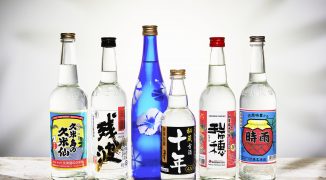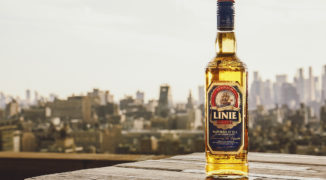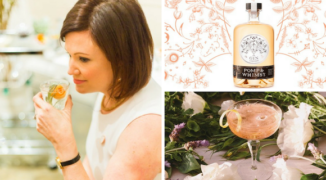It all started at the fourth stop on a five-stop, all day bar crawl, when we noticed a little collection of tiny, paper-wrapped bottles hanging on a post behind the bar—and then a question. “Have you ever tried Underberg?” We hadn’t, but we did about a minute later. I was glad to have been warned about the strong anise taste (among other wintry bitter flavors) — I’ve never been a licorice fan — but, like many, we had pretty strong reactions to it: we were about equally split on liking it and hating it. After that day, those bottles started showing up behind bars all around the city. They’d been there before, of course, but their minuscule size makes it easy for the cult classic to go unnoticed. So what’s their story? And why do so many who know of them love them so much?
This year, in June, Underberg turns 170 years old. It first hit the market in 1846 after founder Hubert Underberg finally settled on a formula with which he could be happy. In 1860, the first American shipment of Underberg arrived in San Francisco, and it’s been sold in the U.S. ever since. After a family rift of sorts in the 1930s, an Underberg brother began distilling a Brazilian Underberg, now known as Brasilberg.
Here in the U.S., Underberg is especially popular in cities with strong German influences: New York, Chicago, St. Louis, Pittsburgh, Cincinnati, Milwaukee and San Francisco, among others, while Brasilberg still doesn’t have the name recognition of its German sibling.
Ted Kilgore, head mixologist and co-owner of Planter’s House in St. Louis, first encountered Underberg in San Francisco, where it all began. He just so happened to see it at a Walgreens there, so he and his wife bought a bottle out of curiosity and had a little bitter breakfast right outside. It’s classified as a food product rather than a liqueur, even though it’s 44% alcohol, and so it can be sold in grocery stores and other places — like pharmacies — instead of being solely relegated to liquor stores, bars and restaurants.
“I think it’s cool because it still got brought into the U.S. during Prohibition,” said Adam Hebert, managing partner at The Radler, a German beer hall-style restaurant in Chicago — another one of those benefits of being classified as a food product.
Though some people stumble upon it, like Kilgore did, many who order it are already quite familiar. Graham Heubach, general manager at Sportsman’s Club in Chicago, finds that oftentimes, proponents of other sorts of bitters can fairly easily get on board with Underberg as well.
“[Y]ou’re kind of already dealing with people, generally, that know what they’re getting into if they’re going to order it by name, so whether or not it’s people who are huge Fernet fans or Campari fans or whatever the case may be, that’s usually a pretty captive audience,” said Heubach.
For those who don’t know what they’re getting themselves into ordering it for the first time, Heubach describes it as sort of an “amped up” root beer that’s been reduced and concentrated.
In Chicago, it’s occasionally compared to Malort (of course).
“It has kind of like a cult following like Malort does, where people either love it or they hate it, and those who love it can’t get enough, and those who hate it still like to pour shots of it to watch people’s faces react, you know?” said Hebert. “But really, it doesn’t taste anything like Malort, it doesn’t taste anything like anything else that’s out there.”
Brad Thomas Parsons, author of “Bitters” and “Amaro,” out in October, is, perhaps unsurprisingly, a sort of Underberg evangelist.
“When I host a talk on bitters or amaro I like to end it with an Underberg toast, and it’s always pure joy to watch the faces of a room full of people simultaneously experiencing it together, especially first-timers,” Parsons said. “It can be rough at first, with its overwhelming frontline assault of alpine herbs. It can feel like a wild, runaway toboggan ride but then the high-alcohol warmth takes over, descending floors like an elevator whose cables have snapped, but in slow motion.”
Another draw is Underberg’s rewards program, which allows bars, restaurants and individuals to redeem saved-up green caps for branded swag: you can spot tiny trucks with Underberg emblazoned on them and bandolier holsters, stocked with paper-wrapped bottles of course, behind the bar at many establishments that carry it.
Though often taken straight, like a shot, Underberg can also be used in cocktails, as you would use another herbal bitter.
When Tyler Fry, bartender at The Violet Hour in Chicago, first started mixing it into drinks, he didn’t notice that happening as often as it is now.
“Now we’ve started to see more folks dashing Underberg into their drinks here and there, but my approach is very different: from the beginning, I wanted to focus on using whole bottles of Underberg in each drink, using it as a major base ingredient, as opposed to a minor modifier,” said Fry. “Very counter-intuitive to its ‘non-potable’ bitters status, which would suggest it should be used in dashes or drops like Angostura et al. The brand also has to be very careful how they promote that sort of use, as they cannot encourage people to use their non-potable alcohol as a beverage. When creative bartenders do, however, they are very supportive and excited to see the product used in new ways. We are seeing a lot more bartenders following suit.”
Hebert likes to add it to a Bloody Mary. At Eclipse Restaurant in St. Louis, the bar staff uses the tiny bottles to garnish a raspberry cocktail called the Devil’s Handshake. Chris Hannah, head bartender at Arnaud’s French 75 in New Orleans, likes to mix it with amaro. At Sportsman’s Club, Heubach made me a riff on a classic Algonquin — rye whiskey, dry vermouth, lime juice, pineapple juice and Underberg bitters to top it off.
“[T]here’s a popular French style of drinking, a very simple French cocktail called a Picon Biere, where you take Amer Picon, which is a bitter orange liqueur, and just put it in a lighter beer, like a light ale or a lager-y kind of thing, and I’ve done that with Underberg on a few occasions, which is another great hangover cure,” Heubach said. “And, you know, I guess in terms of flavors that I usually associate it with or use it with — it’s great in tiki drinks. Anything that’s, like, anise-y or bitter gets really nicely offset with fruity flavors, especially pineapple; it’s so good with pineapple.”
Late night, early morning or during cocktail hour, Underberg is available — and popular — if you know where to look. Just don’t forget to save the cap.





